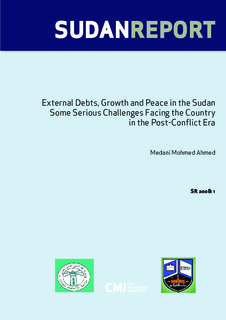| dc.contributor.author | Ahmed, Medani Mohmed | |
| dc.date.accessioned | 2018-01-04T08:19:39Z | |
| dc.date.available | 2018-01-04T08:19:39Z | |
| dc.date.issued | 2008-07-21 | |
| dc.identifier | oai:www.cmi.no:3080 | |
| dc.identifier.citation | Bergen: Chr. Michelsen Institute (CMI Report SR 2008: 1) 76 p. | |
| dc.identifier.isbn | 978-82-8062-245-7 | |
| dc.identifier.issn | 1890-7059 | |
| dc.identifier.uri | http://hdl.handle.net/11250/2475021 | |
| dc.description.abstract | Traditional studies on the external debt problem have focused mainly on the development of the magnitude and trends of the external debt in the low-income countries (LICs) and have then been followed by other studies which have examined the debt burden indicators and severity of the debt problem. However, more recently scholars have concentrated on investigating the impact of the external debt stock and total debt service on growth, investment and public spending as well as service delivery in LICs. The debt overhang and crowding out hypotheses have become increasingly significant research topics. In what follows we will touch briefly on some of these current studies due to their relevance to this work. | |
| dc.language.iso | eng | |
| dc.publisher | Chr. Michelsen Institute | |
| dc.relation | CMI Report | |
| dc.relation | SR 2008: 1 | |
| dc.relation.ispartof | CMI Report | |
| dc.relation.ispartofseries | CMI Report SR 2008: 1 | |
| dc.relation.uri | https://www.cmi.no/publications/3080-external-debts-growth-and-peace-in-the-sudan | |
| dc.subject | Sudan | |
| dc.title | External Debts, Growth and Peace in the Sudan. Some Serious Challenges Facing the Country in the Post-Conflict Era | |
| dc.type | Research report | |
